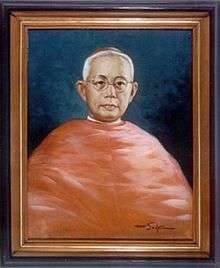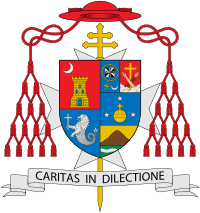Rufino Santos
| His Eminence Rufino J. Cardinal Santos | |
|---|---|
| Cardinal-Archbishop of Manila | |
 | |
| Province | Manila |
| See | Manila |
| Installed | February 10, 1953 |
| Term ended | September 3, 1973 |
| Predecessor | Gabriel M. Reyes |
| Successor | Jaime Sin |
| Other posts | Archdiocese of Manila Military Ordinariate (1951-53) |
| Orders | |
| Ordination | October 25, 1931 |
| Consecration | October 24, 1947 |
| Created Cardinal |
March 28, 1960 by Pope John XXIII |
| Personal details | |
| Birth name | Rufino Jiao Santos |
| Born |
August 26, 1908 Guagua, Pampanga, Philippine Islands |
| Died |
September 3, 1973 (aged 65) Manila, Philippines |
| Buried | Crypt at the Manila Cathedral |
| Nationality | Filipino |
| Denomination | Roman Catholic |
| Parents |
Gaudencio Santos Rosalia Jiao |
| Motto | Caritas in Dilectione "Love in Love" |
| Coat of arms |
 |
Rufino Jiao Santos (August 26, 1908 - September 3, 1973) was the 29th Archbishop of Manila from February 10, 1953 until his death on September 3, 1973, and was the first Filipino elevated to the Cardinalate.
Biography
Born in Barangay Sto. Niño, Guagua, Pampanga, Santos was the fourth of seven children of Gaudencio Santos, an overseer of farmland near Mount Arayat, and Rosalia Jiao. Rufino's three elder brothers were Manuel, Emiliano and Quirino; his three sisters were Clara, Jovita, and Exequiela. Santos, nicknamed "Pinong", grew up in a house located 30 metere from what is now the Immaculate Conception Parish. He was active in church activities as acolyte, and was later a choir member of the Manila Cathedral School. Two factors influenced his priestly vocation: his stint as an altar server, and the encouragement of Father Jose Tahon, Manila Cathedral's parish priest.
He entered San Carlos Seminary on July 25, 1921, and earned a Baccalaureate in Canon Law in 1929 and a Doctorate in Sacred Theology in July 1931 at Pontificia Universita Gregoriana. In 1927, the 19-year-old Santos and Leopoldo A. Arcaira, 24—both outstanding students of San Carlos Seminary—were the first recipients of the scholarships at the Pontifical Gregorian University in Rome, Italy.
Pinong was granted a Papal dispensation to be ordained below the canonical age of 24. On Oct. 25, 1931, two months shy of his 23rd birthday, Rufino J. Santos was ordained priest at the Basilica of Saint John Lateran in Rome.[1] He then served as assistant parish priest in Imus, Cavite and as parish priest in Marilao, Bulacan.
His later successor as Archbishop, Cardinal Gaudencio Rosales, said during the Second World War,
| “ | "Santos saved the life of Manila Archbishop Michael O'Doherty by admitting to the Japanese Army that it was he, as a secretary of the archbishop, who donated food to the poor, including Filipino guerrillas. Refusing to collaborate with the Japanese Army, Santos was sentenced to death but was plucked out by the Combined American and Filipino liberation forces on the night of his execution." | ” |
Archbishop of Manila
In 1953, Santos was appointed Archbishop of Manila on February 10 and was installed on March 25 on the same year. Pope John XXIII elevated him to the cardinalate on 28 March, 1960 making him the first native Filipino to become a cardinal. Santos paved the way for the founding of Catholic Charities (eventually known as Caritas Manila) and the reconstruction of St. Paul Hospital (now the Cardinal Santos Medical Center), which was established by the Maryknoll Sisters, and damaged by American bombardment during the Second World War. Santos also re-instituted the Philippine Trust Company and the Catholic Travel Office.
During his reign, Manila Cathedral (which was destroyed along with the city by Allied bombardment during the 1945 Liberation of Manila) was rebuilt and dedicated to the patronage of the Immaculate Concepcion on December 10, 1958. It was also during his term that Pope Paul VI made a pastoral visit to the Philippines, the first ever by a Pope in the history of the Church in the Philippines. The Pope's journey was also occasioned by the Asian Bishops’ Meeting, which the Pope attended. Santos served as the Archbishop of Manila from 1953 to 1973.
Santos established the Church-run Radio Veritas and built important structures including the Our Lady of Guadalupe Minor Seminary along EDSA in Makati City; the Pius XII Catholic Center in Paco, Manila; and Villa San Miguel, the Archbishop's palace in Mandaluyong.[2][3]
Cardinal Rosales further said that Santos was a diabetic and that he suffered from a malignant brain tumor.[4]
He died in Manila on 3 September 1973, at the age of 65. Following his death, a diplomatic report from the United States Embassy in Manila assessed his activities as follows:
Santos' opposition to "Social Action" programs, which he frequently expressed in heavy-handed fashion, did much to perpetuate the Church's image as a conservative organization, allied with the country's economic and social elite.[5]
| Styles of Rufino J. Cardinal Santos | |
|---|---|
 | |
| Reference style | His Eminence |
| Spoken style | Your Eminence |
| Informal style | Cardinal |
| See | Manila |
Legacy
Caritas Manila’s history began with a Cardinal that "walked the talk".
Cardinal Santos, the first Filipino Cardinal, became the 29th Archbishop of Manila in a post-war scenario that saw a nation plagued with the following: a high dependency on the upper class in the country's social, economic and political growth; a growing inequality in the distribution of wealth; a critical unfairness in labor, land and tenancy—all catalysts to the resurgence of the communist movement. It was to this disparate social order that Cardinal Santos spoke upon his installation:
| “ | I have thought of organizing a social welfare for uplifting the spirit and soul of these unfortunate members of our community. The Archdiocese will lead in this undertaking with an initial amount of fifty to one hundred thousand pesos. Then I expect the more fortunate of the faithful in the Archdiocese to contribute their help in the amount of 1 peso a month for the same purpose, in order that we may budget some two hundred to two hundred fifty thousand pesos a year for buying food, clothing and medicines for distribution among our poor brethren, and the education of their children. | ” |
This plan took shape soon after when the Cardinal appointed an eleven-man Administrative Board on October 1, 1953. And so a new era had dawned, when the establishment of Caritas Manila (first known as Catholic Charities) brought structure and organization to the way the Church’s charitable works in the Archdiocese of Manila were being implemented.
The initial years were largely a period of identifying those who needed help the most, prioritizing and allocating medical aid, food and clothing when needed. These were superseded by programs that harnessed talents and opened up work opportunities for Manila's teeming masses, such as the educational assistance program and job placement program. Nonetheless it was medical assistance, crisis intervention and emergency relief that had the greatest impact, reaching thousands of the sick and indigent. Cardinal Santos was "reviled" for his "conservatism on social issues and business acumen" . However, it was his vision and altruism that had made Caritas Manila a success and his most noteworthy accomplishment.
Birth centennial
The CBCP announced that Cardinal Gaudencio Rosales would lead the August 26, 2008 centennial rites for Santos at his hometown of Sto. Nino, Guagua, Immaculate Conception Parish Church. Gloria Macapagal-Arroyo was to lead the event by unveiling a historical marker and a 6-foot statue of Santos (sculpted by Edillardo Paras) and donated by Cesar L. Villanueva's wife, Arlyn Sicangco-Villanueva, president of Holy Angel University in Angeles City, Pampanga. The rites also included the exhibit of Cardinal Santos memorabilia, loaned by the Archdiocese of Manila and the Kapampangan Museum at Clark.[2] The bronze statue will sit atop a 7-foot concrete pedestal outside the Rufino J. Cardinal Santos Convention Hall adjacent to the parish church. Villanueva also presented to the President, a copy of the book “Padre Pinong, the First Filipino Cardinal” authored by Francis Musni.[4]
See also
- Jose Maria Delgado, Philippine Ambassador to the Vatican
References
- ↑ pia.gov.ph, PGMA unveils commemorative statue of Cardinal Santos in Pampanga
- 1 2 gmanews.tv, Pampanga venue of 1st Filipino cardinal's centennial
- ↑ sunstar.com.ph, Rosales, Arroyo guests at Cardinal Santos centennial
- 1 2 newsinfo.inquirer.net, Arroyo joins Pampanga rites for 1st Filipino cardinal
- ↑ William Healy Sullivan (US Ambassador to the Philippines) to the Sec. of State, September 4, 1973
External links
| Catholic Church titles | ||
|---|---|---|
| Preceded by Fr. Gabriel Reyes |
Archbishop of Manila 1953–1974 |
Succeeded by Jaime Cardinal Sin |
| Preceded by Post Created |
Cardinal-priest of Santa Maria ai Monti 1960 – 1973 |
Succeeded by Jaime Cardinal Sin |
